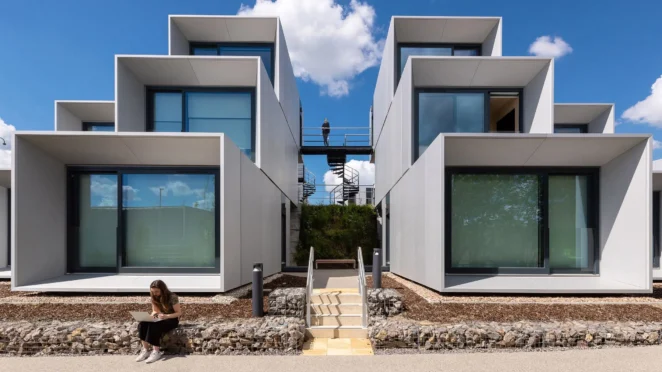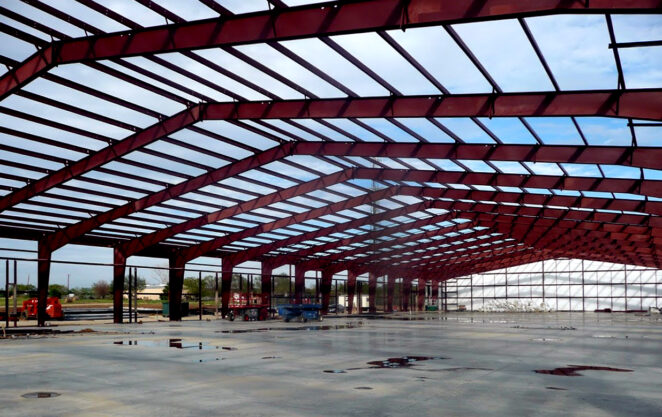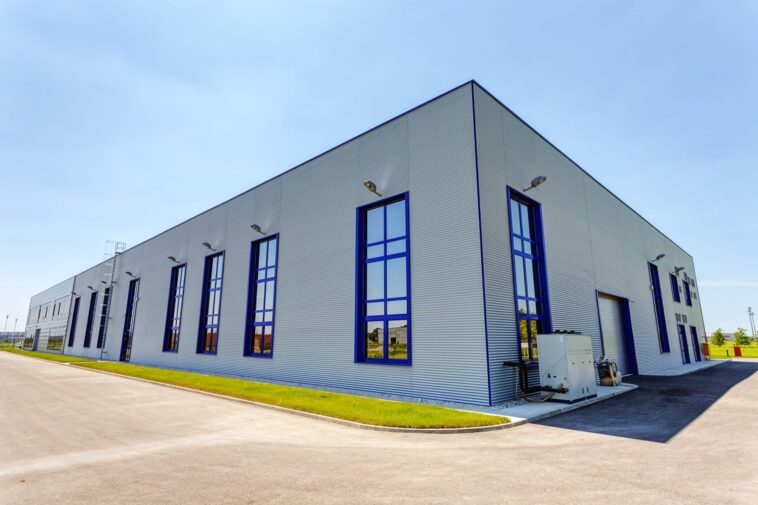Prefab steel office structures have become increasingly popular in recent years due to their numerous benefits. These structures are pre-engineered and fabricated off-site in a controlled factory environment before being transported to the site and assembled on location. Here are some of the benefits of prefab steel office buildings:
1. Durability and Strength
Steel is known for its strength and durability, which makes it an ideal material for office structures. Prefab steel office structures are designed to withstand harsh weather conditions such as heavy snowfall, high winds, and extreme temperatures. They are also resistant to fire, pests, and other potential hazards. This durability and strength ensure that the building will last for many years with minimal maintenance.
Moreover, the strength and durability of steel make it a reliable choice for office structures in terms of structural integrity. Steel has a high strength-to-weight ratio, meaning it can support heavy loads while remaining relatively lightweight. This characteristic allows for larger open floor plans and flexible layouts within the office space.
The durability of steel also translates into long-term cost savings for office owners. Due to its resistance to wear and tear, steel structures require minimal maintenance compared to other building materials. This reduces the need for frequent repairs, replacements, and associated expenses. Additionally, steel is not susceptible to issues such as rot, corrosion, or termite damage, further enhancing its longevity and minimizing maintenance requirements.
The robust nature of steel also contributes to the safety of office occupants. Steel structures are engineered to meet stringent safety standards, providing a secure environment for employees and visitors. They can withstand seismic activity and offer excellent resistance against extreme weather events, reducing the risk of structural failure and ensuring the well-being of those inside.
In addition to its physical attributes, steel also offers design flexibility. It can be easily customized to meet specific architectural and aesthetic requirements, allowing for a wide range of design options. This versatility enables office owners to create visually appealing and functional spaces that align with their branding and corporate image.
Furthermore, using steel in prefab construction methods can significantly reduce construction time and costs. The off-site fabrication of steel components and the ease of assembly on-site result in faster project completion compared to traditional construction methods. This time efficiency can be crucial for businesses that need to occupy the office space quickly and minimize operational disruptions.
Utilizing pre-fabricated steel as the main construction material for office structures definitely comes with a lot of advantages. For business owners who are leaning towards prefab steel for the construction of their offices, you can check out this article on how to choose the right pre-engineered metal building contractor for you to help ensure that you’ll get the most out of your prefab steel structure.
2. Cost-Effective

Prefab steel office structures are a cost-effective option for businesses looking to expand their office space. The prefabricated components of these structures allow for reduced labor costs, less material waste, and more efficient construction methods. Additionally, the shorter construction time means less money spent on temporary office space during the construction phase.
3. Energy Efficiency
Prefab steel office structures are designed to be energy-efficient, which can result in significant cost savings in energy bills over time. The materials used in these structures, such as insulated metal panels, provide excellent insulation, reducing the need for heating and cooling systems. Additionally, these buildings can be designed to maximize natural light, reducing the need for artificial lighting.
Energy efficiency is a key advantage of prefab steel office structures, offering long-term cost savings and environmental benefits. These buildings are designed to optimize energy performance through various features and materials.
Insulated metal panels (IMPs) are commonly used in prefab steel structures and contribute to their energy efficiency. IMPs provide excellent insulation, reducing heat transfer and minimizing the need for excessive heating or cooling systems. The insulation properties of these panels help maintain a comfortable indoor temperature throughout the year, reducing energy consumption associated with HVAC (heating, ventilation, and air conditioning) systems. By minimizing heat loss during colder months and heat gain during warmer months, prefab steel office structures can significantly reduce energy usage and lower utility costs.
Furthermore, the design of these structures can be optimized to maximize natural lighting. Large windows, skylights, and strategically placed openings allow ample daylight to penetrate the building’s interior, reducing the need for artificial lighting. Natural light not only reduces energy consumption but also provides a more pleasant working environment, boosting productivity and well-being among employees.
In addition to insulation and natural lighting, other energy-efficient features can be incorporated into prefab steel office structures. For example, energy-efficient lighting systems such as LED (light-emitting diode) lights can be installed to further reduce electricity consumption. Additionally, the selection of energy-efficient appliances and equipment can contribute to overall energy savings.
The energy efficiency of prefab steel office structures aligns with sustainable building practices and environmental stewardship. By reducing energy consumption and dependence on fossil fuels, these buildings help mitigate greenhouse gas emissions and reduce their ecological footprint. This can be particularly significant for businesses committed to sustainability goals and seeking to minimize their environmental impact.
Furthermore, the energy-efficient design of prefab steel office structures can contribute to obtaining green building certifications, such as LEED (Leadership in Energy and Environmental Design) certification. These certifications not only validate the building’s energy efficiency but also enhance its market value and appeal to environmentally conscious tenants or clients.
4. Quick Construction Time

The prefabricated components of prefab steel office structures mean that the construction time is much shorter than traditional buildings. Since the components are manufactured off-site in a controlled factory environment, there are fewer delays due to weather conditions, labor shortages, or other issues that can slow down traditional construction. This shorter construction time means businesses can move into their new office space much sooner.
5. Customizable Design
Prefab steel office structures offer a high degree of flexibility and customization options. These structures can be designed to fit a wide range of sizes and configurations, making them suitable for various office space needs. Additionally, the modular design of these structures allows for easy expansion or relocation if necessary, providing businesses with the ability to adapt to changing office space requirements over time.
6. Sustainability
Prefab steel office structures are a sustainable option for businesses looking to reduce their environmental impact. Steel is a highly recyclable material, which means that these structures can be disassembled and recycled at the end of their lifespan. Additionally, the energy-efficient design of these buildings can result in lower carbon emissions and reduced energy consumption.
7. Low Maintenance
Steel is a low-maintenance material, which means that prefab steel office structures require minimal upkeep over their lifespan. Steel is resistant to pests, fire, and other potential hazards, reducing the need for costly repairs and replacements. Additionally, the materials used in these structures, such as insulated metal panels, require little to no maintenance.
8. Consistency and Quality

Prefab steel office structures are manufactured in a controlled factory environment, ensuring consistency and quality in the construction process. This means that the building components are manufactured to precise specifications, reducing the risk of errors or defects that can occur during traditional construction. Additionally, since these structures are subject to strict quality control measures, they are often built to a higher standard than traditional buildings.
Potential Challenges of Prefab Steel Office Structures
While prefab steel office structures offer numerous advantages, it’s essential to consider potential challenges. First and foremost is the initial cost. While they provide long-term savings, the upfront investment can be higher than traditional construction. Companies must evaluate their budgets and financial capabilities carefully.
Site Preparation Requirements
Another crucial factor is site preparation. The site must be level, properly graded, and meet specific requirements for the foundation. Inaccurate site preparation can lead to structural issues and increased costs during installation.
Transportation Logistics
Transporting prefab steel components to the construction site requires careful planning. Large and heavy materials may require specialized transportation and equipment. Delays or mishaps during transportation can impact project timelines.
Aesthetic Limitations
While steel offers design flexibility, some businesses may find aesthetic limitations compared to other construction materials like wood or glass. Companies seeking a specific architectural style may need to compromise.
Local Building Regulations
Compliance with local building regulations is paramount. Businesses must navigate zoning laws, permitting requirements, and codes to ensure the prefab steel structure meets all legal obligations.
The involvement of Florida Engineering ensures that every aspect of the prefab steel structure adheres to local building standards, fostering a construction project that is not only efficient and timely but also firmly grounded in legal compliance and safety considerations.
Conclusion
Prefab steel office buildings are durable, cost-effective, energy-efficient, customizable, sustainable, low-maintenance, and built to a high standard of quality. With their quick construction time and flexibility, prefab steel office structures are an excellent option for businesses looking to adapt to changing office space requirements over time.




